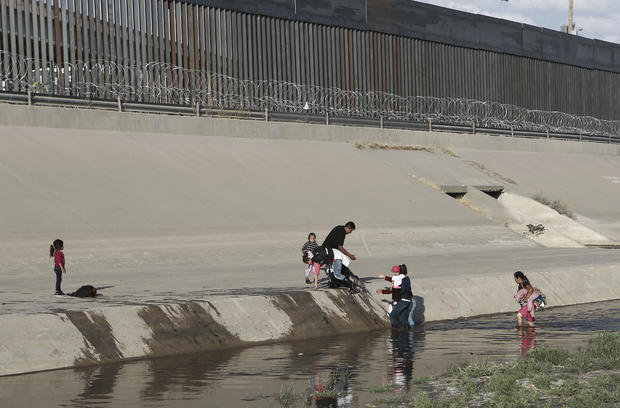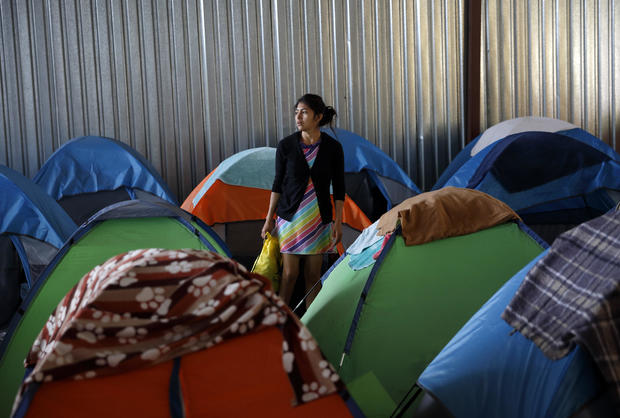Washington — To stem the flow of migration from Central America, the Trump administration is betting on the expansion of a controversial policy that requires asylum seekers to wait for their court hearing in Mexico. But the proposed “full-blown” push to implement the practice along the entire southwestern border faces significant logistical, legal and political barriers.
Under the agreement reached by the U.S. and Mexico to avert President Trump’s threats to impose tariffs on Mexican goods, the Trump administration pledged to immediately begin expanding the Migrant Protection Protocols (MPP) program, known as “Remain in Mexico,” along the southern border. Attorneys and Democrats, however, believe the government is not equipped to rapidly and effectively expand the policy — at least without the process being chaotic and putting thousands of asylum seekers in dangerous situations.
“Realistically speaking, I don’t see any way that the government could expand the program immediately,” Aaron Reichlin-Melnick, a policy analyst at the American Immigration Council, a group that advocates for protection of immigrants and migrants, told CBS News.
Since it was first instituted at the San Ysidro port of entry in San Diego in December 2018, “Remain in Mexico” has been implemented in the border cities of Calexico, California, and El Paso, Texas. As of this week, 11,922 Central American asylum seekers have been returned to Mexico while their cases are processed in court, a Mexican government official told CBS News.
Citing what he called the administration’s new “capacity” to implement the policy “full throttle,” Secretary of State Mike Pompeo has said the expansion will make a “fundamental difference” in the calculus of migrants from Guatemala, Honduras and El Salvador who are considering undertaking the perilous journey north. Last month, U.S. authorities detained more than 130,000 migrants along the southern border — a 13-year high.
Before the roll out of “Remain in Mexico,” asylum seekers who arrived at the three designated ports of entry were allowed to stay in the U.S. to wait for their immigration court appearances. This is still the case along the rest of the border, where migrants seeking asylum are housed in detention centers, temporary tents or shelters. Some are also released into the U.S. when there is no space — which Mr. Trump frequently denounces as “catch and release.”
Prior to MPP’s initial implementation, asylum seekers who came to the U.S. through San Diego, Calexico and El Paso had their cases distributed among immigration courts across the U.S., since some migrants were held by the government in different detention centers, and those who were released moved throughout the country and requested hearings at courts near their new homes.
But with MPP, a small number of judges in San Diego and El Paso are responsible for handling the cases of all migrants who claim asylum at these ports of entry and are sent back to Mexico, creating a bureaucratic logjam that raises questions about the feasibility of expanding the program.
“This will do nothing but make the immigration court backlog massively longer”
Currently, three immigration judges in San Diego are handling the approximately 4,000 asylum claims of migrants who have been returned to Tijuana under “Remain in Mexico.” Those returned from Calexico — which now number more than 2,000 — are usually given a notice to appear in the immigration court in San Diego as well.
In El Paso, just one judge is assigned to these cases. “That means a single judge is being assigned to hear 4,000 cases of people sent back under MPP, ” Reichlin-Melnick from the American Immigration Council said. “As you can imagine, that’s an untenable situation.”
Expanding the program to more ports of entry along the border, Reichlin-Melnick added, will require more courts and judges to adjudicate more asylum cases. He said the expansion will likely prompt the Executive Office for Immigration Review (EOIR), an agency within the Justice Department that adjudicates all immigration cases, to shift resources from cases of immigrants already residing in the U.S.
“They’re not hiring new judges to hear these cases. They’re taking these judges from other dockets and telling them to go do these cases and these cases alone,” he added. “So, really, in many ways, this will do nothing but make the immigration court backlog massively longer.”
The U.S. immigration court system — which is part of the executive branch of the federal government, not the judicial branch — has been facing a burgeoning backlog of cases for years. Currently, nearly 900,000 immigration cases are pending in the system, with about 400 judges to handle them, according to Syracuse University’s Transactional Records Access Clearinghouse (TRAC) center, which tracks immigration court data.
At a hearing before lawmakers on Tuesday, acting Department of Homeland Security (DHS) Secretary Kevin McAleenan said there are approximately 350,000 asylum cases in the backlog.
There are 63 immigration courts across the country, but less than a dozen of them are located within close driving distance of the border, where the asylum cases will be concentrated when MPP expands. Reichlin-Melnick said he’s particularly worried about the access to courts in sprawling areas of Texas, where the closest immigration courts to the border other than the one in El Paso are several hours away, in San Antonio and the Rio Grande Valley, in Harlingen and Port Isabel.
“It’s like they designed the program to fail,” he added. “Despite all the government’s claims, this a program that is about deterrence.”
Lawmakers of both parties recognize the need for more immigration judges. Last month, Sen. Lindsey Graham, one of the White House’s staunchest allies in Congress, introduced a bill that calls for 500 more judges to address the backlog. His proposal, however, would also revamp the entire asylum process by requiring migrants to apply for asylum in their home countries or Mexico, and allow the government to detain migrant families for a longer period of time.
Asked specific questions about its capacity to support the expansion of MPP and any plans to open new courts or hire more judges, the Justice Department’s Immigration Review office sent CBS News a generic statement.
“Continued influxes of illegal immigration along the southwest border strain the Immigration Review office’s resources and increase the backlog, and MPP is one measure implemented by DHS to address those influxes,” a spokesperson for the office wrote, referring all inquiries about the policy expansion to DHS.
A DHS official told CBS News the agency is working closely with the Immigration Review office to make sure all asylum hearings go as planned and to “achieve earlier relief for individuals with meritorious asylum claims, as well as earlier resolution for others, than the current system provides.”
The official did not address questions about the logistical barriers the expansion could face. DHS has also not yet identified new locations for the implementation of the “Remain in Mexico” policy, and the administration has not laid out a timeline for its expansion. DHS is meeting with Mexican officials Friday to discuss three new locations, according to the Mexican foreign ministry.
Looming court ruling
While the government prepares for MPP’s imminent expansion, “Remain in Mexico” faces a legal challenge by a group of immigrant rights groups and asylum seekers who argue that migrants subjected to the policy face great risk and danger in Mexico.
The administration had halted the policy for a few days in April after a federal judge blocked the government from continuing it. That same month, however, the 9th Circuit Court of Appeals granted the government’s emergency motion to stay the lower court’s ruling, allowing DHS to resume the practice.
The 9th Circuit has not made a final ruling but has already heard oral arguments from the government and plaintiffs. DHS did not respond to questions about concerns about expanding the policy while there’s ongoing litigation that could potentially block it.
Judy Rabinovitz, the deputy director of the ACLU Immigrants’ Rights Project and the lead attorney in the group’s lawsuit against “Remain in Mexico,” said the program’s expected expansion does not change its legal strategy, since the group believes the policy is illegal, regardless of where it is implemented.
However, Rabinovitz notes that the expansion could strengthen its arguments against MPP because it could have the effect of further “highlighting the harm” she believes is inflicted on migrants by MPP. She said a push to implement “Remain in Mexico” across the entire U.S.-Mexico border is likely to increase the time migrants spend in Mexico waiting for their court hearing in the U.S.
“If there are delays and they don’t make a point of really trying to make sure that for these returned cases that they put more judges for them, than people are going to be stuck in Mexico even longer.”
Currently, Central American migrants returned under MPP have to wait months for their first court hearing in the U.S. — and during that time, many struggle to find legal counsel, employment, housing and security in Mexico’s border cities.
“I’m worried about people getting killed”
For Democratic Rep. Veronica Escobar, who represents El Paso, another concern about the proposed expansion of MPP is the Mexican government’s ability — and willingness — to ensure that migrants returned under the program have access to basic necessities, like food and shelter.
In its agreement with the U.S., the government of Mexican President Andrés Manuel López Obrador made an extraordinary commitment to provide work permits, health care and education to those returned under MPP. But the Mexican government has yet to detail a plan to accomplish this.
“We don’t even know whether Mexico is ready. If they were ill-equipped and unable to handle an offer of safety and protection for the existing members of the MPP program, how in the world are they going to grow the program?” Escobar told CBS News.
“No one has come to brief Congress. No one has offered us assurances that due process and safety for legal asylum seekers will be upheld,” she added.
Escobar has introduced legislation in the House that would defund MPP. The freshman Democrat said the policy’s expansion — which she noted will further strain the backlog-ridden immigration court system — exacerbates concerns she’s been raising about the security, or lack thereof, of migrants returned under the practice.
The Mexican cities of Tijuana and Ciudad Juarez, which border San Diego and El Paso respectively, are considered to be among the top five most violent cities in the world, according to a 2018 report by a Mexican non-profit that ranked cities based on their homicides rates. If MPP expands along the entire border, some migrants will be forced to wait in Tamaulipas, one of the Mexican states that the State Department warns Americans not to travel to because of high crime rates and the risk of being kidnapped.
Democrats and immigration advocates have been particularly worried about the safety of pregnant women, families with children and LGBTQ individuals subjected to the policy.
“They are being sent into unsafe situations where they are likely to be kidnapped and assaulted,” Escobar said, referring to asylum seekers. “I’m worried about people getting killed. This is horrible. And it should be unacceptable to every American that this is how the Trump administration continues to erode asylum protections.”
Angel Canales contributed to this report.




